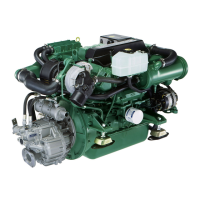Do you have a question about the Volvo Penta TAMD42 and is the answer not in the manual?
Manual requires correct installation. Read safety and general info.
Explains warning, important, and note symbols for risks and information.
Lists essential safety practices for installation and operation.
Details factors like pressure, temperature, humidity, and fuel value affecting engine performance.
Guides proper propeller sizing for optimal performance and engine life.
Guides selecting the engine based on boat type, performance needs, and limitations.
Explains propeller basics, selection methods, and shaft angles for optimal performance.
Covers engine suspension types and propeller shaft system alternatives.
Guides the process of building the engine bed and drilling mounting holes.
Details propeller shaft coupling types and shaft seal lubrication methods.
Instructions for preparing the engine before installation, including fitting accessories.
Covers engine placement on the bed, alignment checks, and mounting adjustments.
Explains fuel flow rates and procedures for checking fuel feed pressure.
Explains freshwater circulation, coolant type, water quality, and anti-siphoning valves.
Details acceptable backpressure limits and consequences of excessive backpressure.
Provides procedures for measuring exhaust backpressure using specific tools.
Covers battery terminology, capacity, and series/parallel connection methods.
Details cable area selection and installation of the main battery switch.
Covers instrument selection, positioning, and tachometer code setting.
Details the process of galvanic corrosion, its causes, and chemical reactions.
Recommends bonding components and using sacrificial anodes for protection.
Guides the design and dimensioning of air intake and outlet ducts for optimal airflow.
Details methods for reducing airborne and structural noise from the engine room.
Guides proper routing of steering cables and hydraulic hoses to ensure smooth operation.
Covers mechanical, electrical, and electro-mechanical control systems.
Details cable routing for mechanical controls and neutral safety switch installation.
Guides connecting speed and gear-shift cables to the engine and reverse gear.
Lists essential checks before launching the boat, including batteries and fittings.
Covers checks for instruments, leaks, engine speed, and backpressure during a sea trial.
Evaluates engine room temperature, noise, vibrations, and control responsiveness.
Manual requires correct installation. Read safety and general info.
Explains warning, important, and note symbols for risks and information.
Lists essential safety practices for installation and operation.
Details factors like pressure, temperature, humidity, and fuel value affecting engine performance.
Guides proper propeller sizing for optimal performance and engine life.
Guides selecting the engine based on boat type, performance needs, and limitations.
Explains propeller basics, selection methods, and shaft angles for optimal performance.
Covers engine suspension types and propeller shaft system alternatives.
Guides the process of building the engine bed and drilling mounting holes.
Details propeller shaft coupling types and shaft seal lubrication methods.
Instructions for preparing the engine before installation, including fitting accessories.
Covers engine placement on the bed, alignment checks, and mounting adjustments.
Explains fuel flow rates and procedures for checking fuel feed pressure.
Explains freshwater circulation, coolant type, water quality, and anti-siphoning valves.
Details acceptable backpressure limits and consequences of excessive backpressure.
Provides procedures for measuring exhaust backpressure using specific tools.
Covers battery terminology, capacity, and series/parallel connection methods.
Details cable area selection and installation of the main battery switch.
Covers instrument selection, positioning, and tachometer code setting.
Details the process of galvanic corrosion, its causes, and chemical reactions.
Recommends bonding components and using sacrificial anodes for protection.
Guides the design and dimensioning of air intake and outlet ducts for optimal airflow.
Details methods for reducing airborne and structural noise from the engine room.
Guides proper routing of steering cables and hydraulic hoses to ensure smooth operation.
Covers mechanical, electrical, and electro-mechanical control systems.
Details cable routing for mechanical controls and neutral safety switch installation.
Guides connecting speed and gear-shift cables to the engine and reverse gear.
Lists essential checks before launching the boat, including batteries and fittings.
Covers checks for instruments, leaks, engine speed, and backpressure during a sea trial.
Evaluates engine room temperature, noise, vibrations, and control responsiveness.
| Engine Type | Diesel |
|---|---|
| Displacement | 4.2 L |
| Fuel Type | Diesel |
| Cooling System | Freshwater cooled |
| Cylinders | 6 |
| Stroke | 120 mm |
| Compression Ratio | 17.5:1 |
| Fuel System | Direct injection |
| Torque | 520 Nm at 2600 rpm |
| Power Output | 169 kW (230 hp) at 3800 rpm |











